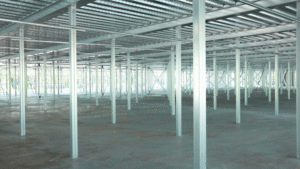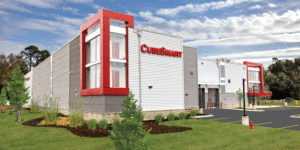The Self Storage Sector
by Stacy Rinella | October 29, 2024 8:00 am
 [1]
[1]Photos courtesy Elevate Structures
The self-storage industry has continued to evolve throughout 2024, driven by various economic and market factors. This midyear review highlights key trends influencing the sector, including the impact of interest rates, economic adaptations, cost-saving opportunities, and innovative construction practices.
Influence of interest rates
The self-storage construction market remains highly influenced by interest rates, with higher borrowing costs leading to a notable slowdown in 2024. As of June, over 3,000 properties nationwide are in various stages of development, yet the number of abandoned or canceled projects continues to rise. This increase in project cancellations is primarily due to the elevated cost of debt, which has made financing more expensive and less accessible.
Despite these financial challenges, the self-storage sector remains resilient. Construction activities are strategically planned and based on regional demand. High-growth areas are seeing more new development, while saturated markets are witnessing more conservative growth strategies. Occupancy rates have softened slightly in some areas but remain stable, supporting the ongoing demand for self-storage solutions.
 [2]
[2]
Develop a strategic market focus
Well-capitalized investors and developers with strong financial backing are progressing with projects, albeit slowly. In tertiary markets, some developers focus on new construction, including specialized types of storage, while others are converting existing structures, like empty warehouses or retail spaces, to keep projects cost-effective.
 [3]
[3]Urban developers increasingly opt for vertical construction in new mixed-use and multi-level buildings. This approach maximizes space efficiently in densely populated areas and caters to the high demand for storage space. Integrating self-storage facilities into mixed-use developments—combining storage with residential, retail, and office spaces—optimizes land use and creates multifunctional properties. Proposals for such projects often include structures ranging from three to 10 stories, featuring retail, office, and restaurants on the bottom two floors, several floors of storage above, and residential units on the top. This integration offers numerous benefits, including optimized land use, increased property value, enhanced convenience, and sustainability, making mixed-use developments an attractive and practical solution for urban planning and development, catering to the diverse needs of modern urban populations.
Jurisdictions that have adopted the 2021 International Building Code (IBC) facilitate the development of these types of vertical structures. The IBC allows for more cost-effective value engineering, enhancing construction efficiency.
 [4]
[4]
Specialty storage
Boat and RV storage has increased, especially near recreation areas, as the popularity of recreational vehicles and boat ownership has surged, creating higher demand. Many owners seek secure storage solutions during off-season periods, particularly in regions with harsh winters. Dedicated spaces designed specifically for boats and RVs, catering to their size and storage requirements, with enhanced security and premium amenities, are transforming the landscape of boat and RV storage.
General contractor cost management
With rising construction costs and interest rates, developers focus on working with general contractors, promoting cost-effective building methods and materials. Utilizing factory-pre-assembled building components in metal construction enhances efficiency, quality, and cost-effectiveness. These pre-assembled components reduce on-site labor costs, shorten construction time by allowing other trades to start sooner, ensure consistent quality, minimize waste, and leverage economies of scale. This approach provides significant financial and operational advantages when implemented as part of on-site construction methods.
Sustainability leveraging renewable energy
In addition to market-focused development and cost-effective construction, architects and general contractors are designing facilities focusing on sustainability and eco-friendly technologies. Facilities are incorporating energy-efficient technologies such as LED lighting and smart climate control systems to reduce energy consumption. Storage facilities of all types are increasing the use of renewable energy sources like solar panels to power facilities and reduce environmental impact. These solar panels are often incorporated into boat and RV storage facilities that feature covered parking.
Enhanced security
and accessibility
Architectural designs now prioritize enhanced security features such as secure perimeters, advanced surveillance systems, and controlled access points. Additionally, accessibility improvements like wider corridors, larger elevators, and loading bays are being integrated to facilitate ease of use.
Smart technology Integration
Another emerging trend is the integration of smart technologies into architectural design. This includes features like automated lighting, climate control systems, and smart security systems that can be managed remotely, enhancing operational efficiency and customer convenience.
As 2024 progresses, these trends are expected to shape the self-storage industry, driving innovation and efficiency while meeting the evolving needs of consumers and developers alike.
Shannon Conrady is the director of marketing at Elevate Structures. She oversees the strategic planning and execution of marketing campaigns and web development. Conrady has more than 20 years of sales, marketing, and operation experience in the manufacturing and construction industry, with a passion for building up structures, people, and good ideas.
- [Image]: https://www.metalarchitecture.com/wp-content/uploads/2024/10/money-shot-7.gif
- [Image]: https://www.metalarchitecture.com/wp-content/uploads/2024/10/C_R_4413-Edit-2.gif
- [Image]: https://www.metalarchitecture.com/wp-content/uploads/2024/10/Suffolk-4_edit.gif
- [Image]: https://www.metalarchitecture.com/wp-content/uploads/2024/10/NCA_ES_DAYTONA-7.gif
Source URL: https://www.metalarchitecture.com/articles/the-self-storage-sector/